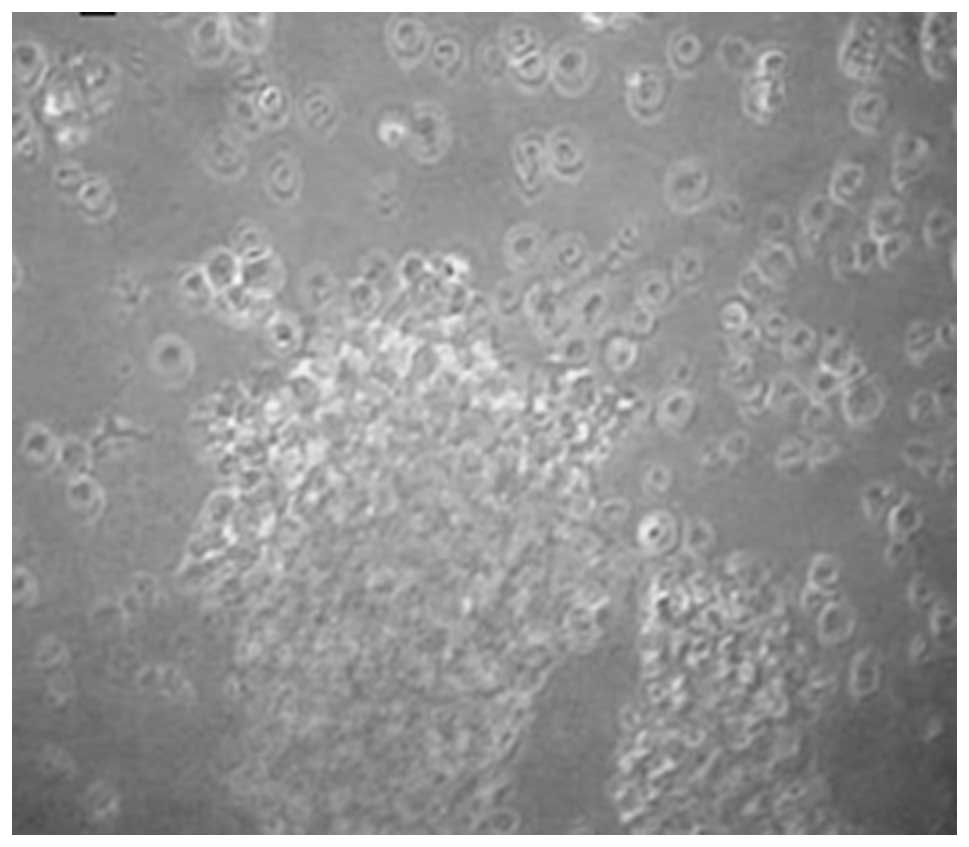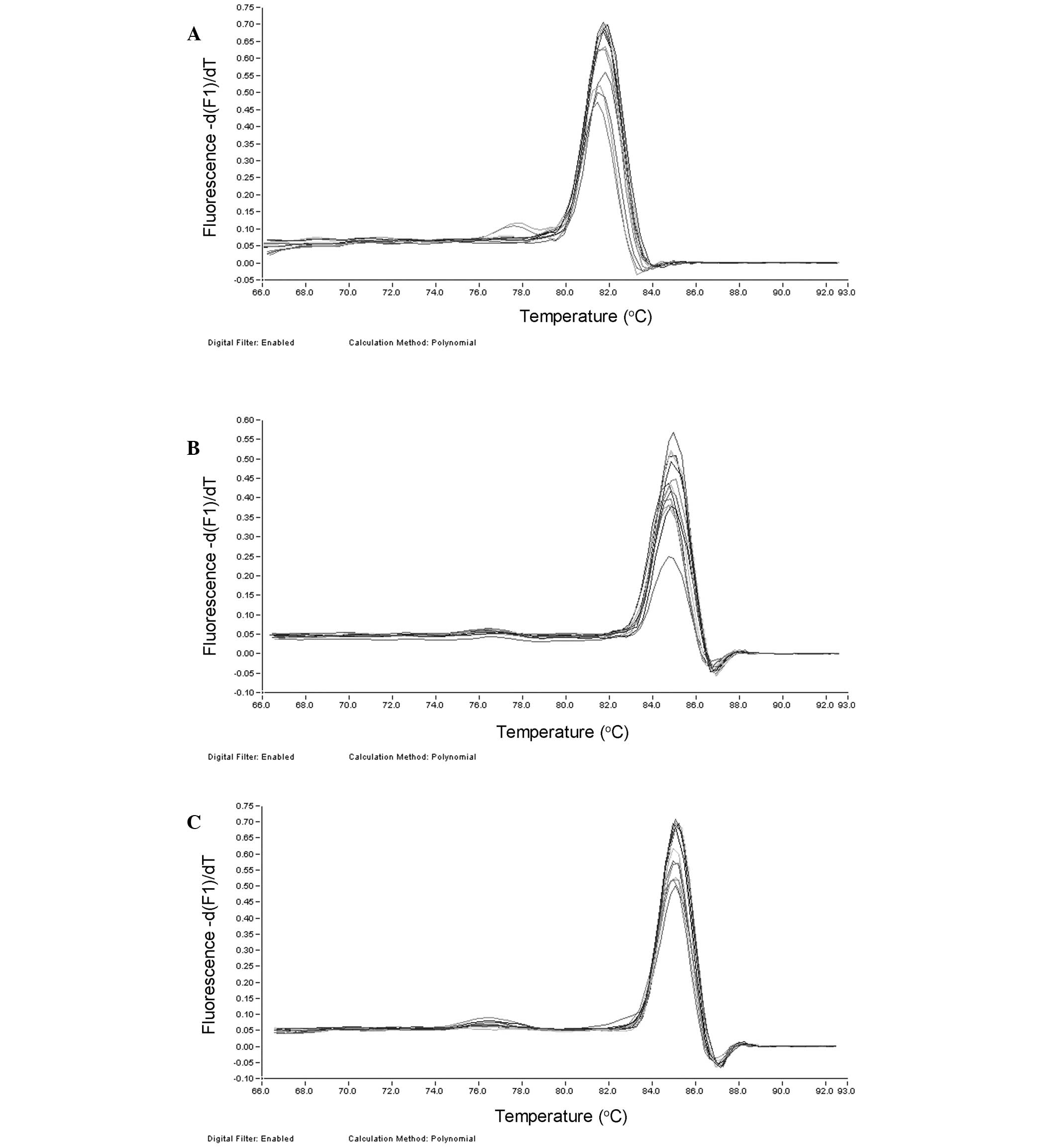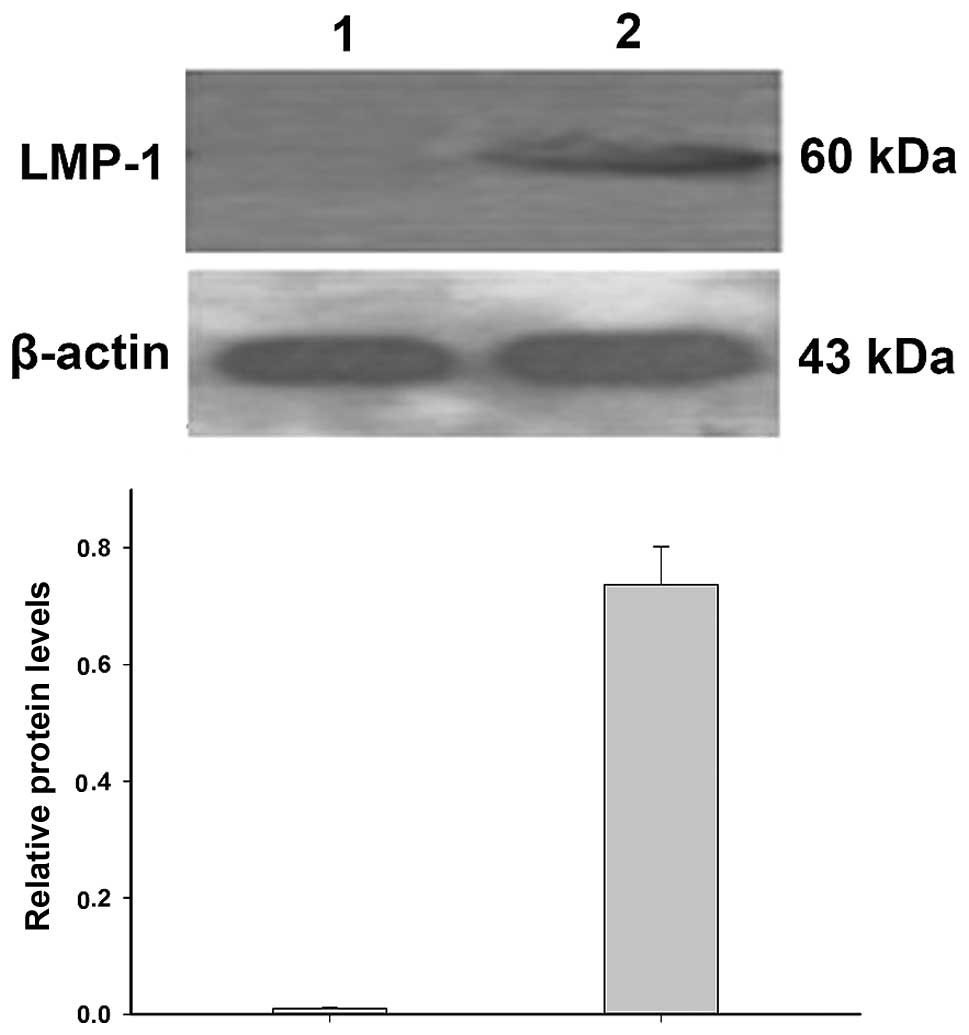Expression of latent membrane proteins in Epstein‑Barr virus-transformed lymphocytes in vitro
- Authors:
- Published online on: June 10, 2014 https://doi.org/10.3892/mmr.2014.2313
- Pages: 1117-1121
Abstract
Introduction
Epstein-Barr virus (EBV) is a double-stranded DNA virus of the herpes family, that targets lymphocytes and is closely associated with multiple malignancies, including lymphoma, nasopharyngeal cancer and gastric cancer (1). Epithelial cells, lymphocytes and muscle cells are particularly vulnerable to EBV (2). Similar to other herpes viruses, EBV has the capacity to induce lytic and latent infection. Latent EBV infection results in the expression of only minimal numbers of viral proteins, but it is able to bypass host immune surveillance and thus carries a tumorigenic risk. Despite this, cytologists often encounter EBV-associated malignancies in cytological material, but in contrast to other herpes viruses, EBV does not evoke viral cytopathic effects, such as cell merging and necrosis (2). In vitro infection with EBV induces activation and proliferation of human B lymphocytes (3). EBV-specific cytotoxic CD8+ T cells are responsible for the clearance of EBV-infected lymphocytes by recognizing the virus-coded proteins and therefore the majority of EBV carriers are asymptomatic throughout life (3). Expression of LMP-1 protein is associated with the proliferation of B lymphocytes. By contrast, LMP-1 protein is absent in latent infection with EBV type I and IIb, and infected cells have no inherent proliferation capacity (4). Therefore, LMP-1 expression is used to determine the proliferative ability of B lymphocytes.
Latent membrane proteins (LMPs) have three subtypes, LMP-1, LMP-2A and LMP-2B. Expression of the three genes during EBV-induced transformation of human B lymphocytes has not been investigated. In the present study, the expression of LMP-1, LMP-2A and LMP-2B genes in EBV-induced lymphoblasts and paired normal lymphocytes was compared to elucidate its significance during lymphocyte transformation.
Materials and methods
Blood samples
Peripheral blood was collected from seven healthy volunteers. The study was approved by the Ethics Committee of University of South China, Hengyang, China. Written informed consent was obtained from the patients. EBV infection status was detected with an ELISA kit (ADL Embedded Solutions Inc., San Diego, CA, USA) using the anti-EBV-VCA IgG antibody (ADL Embedded Solutions Inc.). DNA was extracted from the whole blood samples and the LMP-1 gene sequence (82 bp, GI: 896226) was expanded using polymerase chain reaction (PCR). The upstream primer of the LMP-1 gene was: 5′-CTG CTC ATC GCT CTC TGG AA-3′ and the downstream primer was: 5′-AGA CAA GTA AGC ACC CGA AGA TG-3′. The PCR included 30 cycles of 94°C for 4 min, 94°C for 30 sec, 52°C for 30 sec and 72°C for 30 sec, and a final extension at 72°C for 5 min. The PCR products were separated on 2% agarose gels. The results demonstrated EBV latency in the seven blood samples.
Isolation of lymphocytes
Peripheral blood (50 ml) was collected from seven healthy volunteers. Normal PBLs were separated from fresh peripheral blood samples using human lymphocyte separation medium (catalogue no. LTS1077; Tian Jin Hao Yang Biological Manufacture Co., Ltd., Tianjin, China) and washed twice with RPMI-1640.
Isolation of EBV
The B95-8 marmoset cell line was kindly provided by the Cancer Research Institute, Central South University, Changsha, China and used as a source of EBV. The culture medium of B95-8 cells was replenished for the final time. The cell density was adjusted to 106–107/ml. The cells were starved for 10 days at 37°C in 5% CO2 and were then centrifuged at 3,700 × g at 4°C for 30 min. The supernatant was passed through a 0.45-μm filter and stored at −80°C.
Preparation of lymphoblasts
A total of 2×106–3×106 lymphocytes were suspended in 2 ml RPMI-1640 culture medium supplemented with 25% fetal bovine serum (Gibco, Sydney, Australia) and 2 μg/ml cyclosporine A (Sandoz, Basel, Switzerland). The cells were transferred into a 24-well plate and incubated at 37°C with 5% CO2 for one week. Subsequently, the lymphocytes were induced into lymphoblasts that were enlarged and exhibited cell clustering. The culture medium was replenished every 3–4 days and ~4 weeks later the cells were transferred into 25-ml flasks for further culture.
Quantatitive (q)PCR
Total RNA was extracted from lymphoblasts, untreated lymphocytes and B95-8 cells using TRIzol reagent (Invitrogen Life Technologies, Carlsbad, CA, USA). A total of 2×106 cells were used for RNA extraction. The purity and integrity of the extracted RNA were examined using electrophoresis. RNA was reverse transcribed into cDNA (Promega Corporation, Madison, WI, USA) according to the manufacturer’s instructions. The primers used in the qPCR are listed in Table I. The B95-8 cells that expressed the EBV genome were used as a positive control to establish the standard curve for qPCR. Each test was repeated twice.
Western blotting
Total protein was extracted from the cells using SDS lysis buffer (Beyotime, Shanghai, China) and quantified using an Enhanced Bicinchoninic Acid Protein Assay kit (Beyotime). The protein was denatured at 95°C for 10 min and then 50 μg was separated in 8–12% SDS-PAGE and transferred onto a nitrocellulose membrane (Beyotime). The membrane was blocked with 5% skimmed milk in Tris buffer (25 mM Tris-HCl, 150 mM NaCl and 0.05% Tween-20, pH 7.5). Mouse anti-LMP-1 monoclonal antibody (1:200; DakoCytomation, Glostrup, Denmark) and mouse anti-β-actin monoclonal antibody (1:1000; ComWin, Beijing, China) were added and the membranes were incubated at 4°C overnight. Goat anti-mouse IgG (1:1000; ComWin) was used as a secondary antibody, incubated at room temperature for 2 h. Each test was performed in triplicate.
Statistical analysis
All the data are expressed as the mean ± standard deviation. Data were analyzed using one-way analysis of variance. P<0.05 was considered to indicate a statistically significant difference.
Results
Lymphoblast morphology
EBV-transformed lymphoblasts (LCLs) were round or oval and enlarged in size compared with the normal lymphocytes (Fig. 1).
Expression of LMP genes
Melting curve analysis demonstrated only one specific peak for LMP-1, LMP-2A and LMP-2B, indicating high specificity of the qPCR (Fig. 2).
PCR products of LMP genes were separated on 2% agarose gels, which revealed well-separated bands of the predicted sizes (Fig. 3).
Expression levels of LMP-1, LMP-2A and LMP-2B in EBV-transformed lymphoblasts were 863-fold (P<0.01), 1,763-fold (P<0.05) and 90,078-fold (P<0.05) of that in untreated lymphocytes, respectively (Table II).
Detection of LMP-1 protein levels
Western blotting demonstrated that LMP-1 protein levels were significantly increased in EBV-transformed lymphoblasts compared with that in the normal lymphocytes (P<0.05; Fig. 4), which is consistent with the results of qPCR.
Discussion
EBV is considered to be associated with several malignancies, including Hodgkin’s lymphoma, NK-T cell lymphoma, Burkitt’s lymphoma and nasopharyngeal cancer (5). Latent EBV infection induces the expression of three LMP proteins, LMP-1, LMP-2A and LMP-2B (6). LMP-1 is the major factor that induces transformation and tumorigenesis of B cells (7) and mimics the constitutionally activated receptor of tumor necrosis factor (TNF), CD40. LMP-1, via this TNF receptor, regulates cell proliferation and death (8) and is thus important in cell growth, differentiation and apoptosis. LMP-2A and LMP-2B are two isoforms of the LMP-2 protein expressed in B cells with latent EBV infection (9). LMP-2 proteins promote the development and progression of tumors (10). LMP-2A in particular, has been demonstrated to protect B cells from various proapoptotic mechanisms (11).
EBV latency in healthy carriers is usually asymptomatic. In the present study, it was identified that expression of LMP mRNA in normal lymphocytes was low at 10−4–10−5, which was significantly upregulated in the EBV-induced lymphoblasts at 2×10−2. The expression levels of LMP mRNA were determined using qPCR.
The expression of the LMP-1 gene was significantly increased in the EBV-transformed lymphoblasts at the mRNA (863-fold; P<0.01) and protein levels compared with that in normal lymphocytes. Rasul et al (3) cultured mononuclear cells with the supernatant of B95-8 cells for 1.5 h to infect B cells with EBV. By using immunostaining and western blotting following seven days in culture, it was identified that the B cells expressing LMP-1 protein were mostly positive for Ki-67, while those not expressing LMP-1 protein demonstrated a weak Ki-67 expression and were non-proliferative. Only EBV nuclear antigen (EBNA)-1 was expressed in cells with type I EBV latency, and these cells were nonproliferative and revealed a resting B cell phenotype, which was also observed in the control memory B cells in healthy individuals. B cells with type IIb EBV latency expressed all the EBNAs but not LMP-1, and these cells were also non-proliferative (4). Therefore, it was considered that the expression of LMP-1 is critical in the proliferation and transformation of B cells (12). EBV-induced immortal lymphoblasts promoted lymphoma genesis (13). Increased expression of LMP-1 mRNA and protein promoted the proliferation of NK/T lymphoma cells (14). LMP-1 expression is also a typical feature of R/S cells in Hodgkin’s lymphoma and improves the survival and proliferation of R/S cells by altering the cellular phenotype and interacting with the surrounding microenvironment (3).
The mechanisms underlying the proliferation and transformation of B cells promoted by LMP-1 may include the activation of cell signaling pathways and the increase in cell cycle activators. It has been demonstrated that LMP-1 activates β-catenin via the phosphatidylinositol 3-kinase/AKT pathway, thus promoting the proliferation of EBV-infected B cells (7). LMP-1 regulates the expression of death-associated protein kinase 1 and activates nuclear factor (NF)-κB signaling in LCL cells, thus upregulating the MHC class I antigen processing pathway (8). LMP-1 also induces CD8+ T cell reaction and bypasses immune surveillance (15). The expression of LMP1-induced protein (LMPIP) is increased in EBV-infected peripheral lymphocytes and LMP-1-transfected 293 cells. Nasopharyngeal carcinoma cells overexpressing LMPIP demonstrated a decrease in G1 phase cells and an increase in sub-G1 phase cells, accompanied by an increase in cell cycle activators cyclin D1 and cyclin-dependent kinase 4 (16). It has also been revealed that EBV promotes epithelial tumorigenesis by downregulating microRNA-203 via LMP-1 (17).
In the present study, it was identified that expression of LMP-2A in EBV-transformed lymphoblasts was 1,763-fold (P<0.05) of that in untreated lymphocytes, suggesting that LMP-2A is important in B cell transformation. LMP-2A maintains the persistence of EBV infection by inhibiting the activation of B cells. LMP-2A mRNA is consistently expressed in primary and metastasized nasopharyngeal cancer, suggesting that LMP-2A has an initiating role in EBV-associated malignancy (5). LMP-2A regulates the expression of tumor necrosis receptor-associated factor 2 and thus modulates LMP-1-induced activation of the NF-κB pathway, finally preventing the apoptosis of lymphoma cells (18,19). LMP-2A induces expression of ΔNp63α and regulates the proliferation, transformation and differentiation of epithelial cells, which may promote the growth of malignant tumors (20). It has also been identified that LMP-2A promotes malignant transformation by enhancing the cell cycle, inhibiting apoptosis and regulating LMP-1 expression (11). These results suggest that LMP-2A is important in the processes of transformation and tumorigenesis.
It was also identified that the expression of LMP-2B in EBV-transformed lymphoblasts was 90,078-fold (P<0.05) greater than that in the untreated lymphocytes. LMP-2B modulates the activity of LMP-2A during the transformation of B cells and maintains persistent EBV latency together with LMP-2A (21). LMP-2B inhibits LMP-2A and prevents the potential lytic viral replication of EBV. In addition, upregulated expression of LMP-2B promotes the progression from EBV latency to replicative infection (9).
In conclusion, LMP-2A and LMP-1 promote the proliferation, survival and transformation of B cells. LMP-1 and LMP-2 are frequently expressed in EBV-associated lymphoma and epithelial carcinoma, and therefore may promote tumor progression.
Acknowledgements
This study was supported by the National Natural Science Foundation of China (grant nos. 81272182 and 81372134) and the Construct Program of the Key Discipline in Hunan Province (grant no. 2011-76).
References
|
Lan K, Verma SC, Murakami M, Bajaj B and Robertson ES: Epstein-Barr Virus (EBV): infection, propagation, quantitation, and storage. Curr Protoc Microbiol. Chapter 14(Unit 14E): 122007.PubMed/NCBI | |
|
Michelow P, Wright C and Pantanowitz L: A review of the cytomorphology of Epstein-Barr virus-associated malignancies. Acta Cytol. 56:1–14. 2012. View Article : Google Scholar : PubMed/NCBI | |
|
Rasul AE, Nagy N, Sohlberg E, Ádori M, Claesson HE, Klein G and Klein E: Simultaneous detection of the two main proliferation driving EBV encoded proteins, EBNA-2 and LMP-1 in single B cells. J Immunol Methods. 385:60–70. 2012. View Article : Google Scholar : PubMed/NCBI | |
|
Klein E, Kis LL and Klein G: Epstein-Barr virus infection in humans: from harmless to life endangering virus-lymphocyte interactions. Oncogene. 26:1297–1305. 2007. View Article : Google Scholar : PubMed/NCBI | |
|
Pang MF, Lin KW and Peh SC: The signaling pathways of Epstein-Barr virus-encoded latent membrane protein 2A (LMP2A) in latency and cancer. Cell Mol Biol Lett. 14:222–247. 2009.PubMed/NCBI | |
|
Kanegane H, Yachie A, Miyawaki T and Tosato G: EBV-NK cells interactions and lymphoproliferative disorders. Leuk Lymphoma. 29:491–498. 1998. View Article : Google Scholar : PubMed/NCBI | |
|
Tomita M, Dewan MZ, Yamamoto N, Kikuchi A and Mori N: Epstein-Barr virus-encoded latent membrane protein 1 activates beta-catenin signaling in B lymphocytes. Cancer Sci. 100:807–812. 2009. View Article : Google Scholar : PubMed/NCBI | |
|
Lee CW, Leu SJ, Tzeng RY, et al: Latent membrane protein 1 of Epstein-Barr virus regulates death-associated protein kinase 1 in lymphoblastoid cell line. Virology. 413:19–25. 2011. View Article : Google Scholar : PubMed/NCBI | |
|
Rechsteiner MP, Berger C, Zauner L, et al: Latent membrane protein 2B regulates susceptibility to induction of lytic Epstein-Barr virus infection. J Virol. 82:1739–1747. 2008. View Article : Google Scholar : PubMed/NCBI | |
|
Shair KH, Bendt KM, Edwards RH, Nielsen JN, Moore DT and Raab-Traub N: Epstein-Barr virus-encoded latent membrane protein 1 (LMP1) and LMP2A function cooperatively to promote carcinoma development in a mouse carcinogenesis model. J Virol. 86:5352–5365. 2012. View Article : Google Scholar | |
|
Bultema R, Longnecker R and Swanson-Mungerson M: Epstein-Barr virus LMP2A accelerates MYC-induced lymphomagenesis. Oncogene. 28:1471–1476. 2009. View Article : Google Scholar : PubMed/NCBI | |
|
Zhang B, Kracker S, Yasuda T, et al: Immune surveillance and therapy of lymphomas driven by Epstein-Barr virus protein LMP1 in a mouse model. Cell. 148:739–751. 2012. View Article : Google Scholar : PubMed/NCBI | |
|
Dellis O, Arbabian A, Papp B, Rowe M, Joab I and Chomienne C: Epstein-Barr virus latent membrane protein 1 increases calcium influx through store-operated channels in B lymphoid cells. J Biol Chem. 286:18583–18592. 2011. View Article : Google Scholar | |
|
Ramakrishnan R, Donahue H, Garcia D, Tan J, Shimizu N, Rice AP and Ling PD: Epstein-Barr virus BART9 miRNA modulates LMP1 levels and affects growth rate of nasal NK T cell lymphomas. PLoS One. 6:e272712011. View Article : Google Scholar : PubMed/NCBI | |
|
Yoshizaki T: A novel immune evasion mechanism of LMP-1, an EBV-primary oncogene, in nasopharyngeal carcinoma. Adv Otorhinolaryngol. 72:157–159. 2011.PubMed/NCBI | |
|
Wang LT, Lin CS, Chai CY, Liu KY, Chen JY and Hsu SH: Functional interaction of Ugene and EBV infection mediates tumorigenic effects. Oncogene. 30:2921–2932. 2011. View Article : Google Scholar : PubMed/NCBI | |
|
Yu H, Lu J, Zuo L, et al: Epstein-Barr virus downregulates microRNA 203 through the oncoprotein latent membrane protein 1: a contribution to increased tumor incidence in epithelial cells. J Virol. 86:3088–3099. 2012. View Article : Google Scholar | |
|
Guasparri I, Bubman D and Cesarman E: EBV LMP2A affects LMP1-mediated NF-kappaB signaling and survival of lymphoma cells by regulating TRAF2 expression. Blood. 111:3813–3820. 2008. View Article : Google Scholar : PubMed/NCBI | |
|
Vrazo AC, Chauchard M, Raab-Traub N and Longnecker R: Epstein-Barr virus LMP2A reduces hyperactivation induced by LMP1 to restore normal B cell phenotype in transgenic mice. PLoS Pathog. 8:e10026622012. View Article : Google Scholar : PubMed/NCBI | |
|
Fotheringham JA, Mazzucca S and Raab-Traub N: Epstein-Barr virus latent membrane protein-2A-induced DeltaNp63alpha expression is associated with impaired epithelial-cell differentiation. Oncogene. 29:4287–4296. 2010. View Article : Google Scholar : PubMed/NCBI | |
|
Rechsteiner MP, Bernasconi M, Berger C and Nadal D: Role of latent membrane protein 2 isoforms in Epstein-Barr virus latency. Trends Microbiol. 16:520–527. 2008. View Article : Google Scholar : PubMed/NCBI |













